Sennheiser HMEC 46-1 User Manual
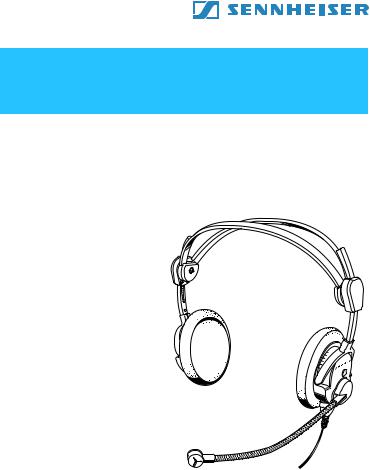
HMEC 46-1
Instructions for use
Safety instructions
•Please read this instruction manual carefully and completely before using the headset.
•Make this instruction manual easily accessible to all users at all times.
•Always include this instruction manual when passing the headset on to third parties.
•During flight operation, do not use the headset for telephone calls.
•With the NoiseGard™ active noise compensation switched on, typical aircraft sounds (for example, those from engines, propellers, warning alarms, etc.) may sound different to you. Before operating any aircraft, make sure that, with NoiseGard™ switched on, you can hear and recognize these sounds. Set the volume to safe levels that do not interfere with your ability to hear informational sounds and warning alarms.
•The headset is capable of producing sound pressure levels exceeding 85 dB(A). In many countries 85 dB(A) is the maximum legally permissible level for continuous noise exposure during the working day. Exposure to sounds of higher volume levels or for longer durations can permanently damage your hearing!
•Never repair or attempt to repair a defective headset yourself. Contact your Sennheiser agent or the Sennheiser Service Department.
1
•Only replace those parts of the headset whose replacement is described in this instruction manual. All other parts of the headset must be replaced by your Sennheiser agent.
•Protect the headset from humidity. Use only a slightly damp cloth to clean the headset. For information on how to clean the headset, contact your Sennheiser agent.
Intended use of the headset
Intended use includes:
•having read this instruction manual especially the chapter “Safety instructions”.
•using the headset in aircraft cockpits and within the operating conditions as described in this instruction manual.
Improper use
Improper use means using the headset other than as described in this instruction manual, or under operating conditions which differ from those described herein.
2
The HMEC 46-1 headset
The HMEC 46-1 headset with NoiseGard™ active noise compensation features dynamic, open headphones. The noisecompensating condenser microphone ensures excellent speech transmission even in noisy environments. Designed for use in aircraft cockpits.
Features
•NoiseGard™ active noise compensation reduces ambient noise by at least 15 dB – consequently the radio volume can be decreased
•Extremely lightweight
•Extremely comfortable to wear due to the patented two-piece automatic headband and soft ear pads
•Peak level protection safeguards you from volume peaks above 110 dB
•“Flip-away” headphone allows single-sided listening
•Flexible microphone boom, can be worn on either left or right-hand side
•Noise-compensating condenser microphone ensures excellent speech transmission
•Single-sided cable, easy to replace
•With NoiseGard™ switched off, the headset can be used as a conventional headset
•Power supply for NoiseGard™ from aircraft DC power supply system (on suitably equipped aircraft) or batteries/rechargeable batteries
•“Auto shut-off” extends battery life
•ETSO (C57a/C58a)/TSO (C139) approval
3
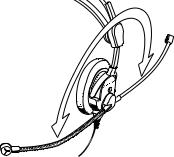
Delivery includes
•HMEC 46-1 headset
•Cable clip
•Wind and pop screen
•Instruction manual
•Carry bag
•EASA Form 1
Operation
Turning the microphone boom
The microphone boom can be rotated. This allows the headset to be worn with the microphone boom positioned on either the left or right-hand side of the head.
4
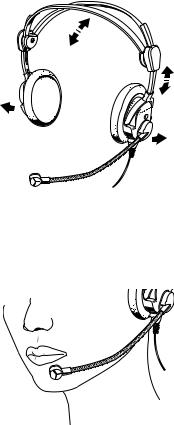
Putting on the headset
When putting on the headset, the patented two-piece headband adjusts automatically.
Positioning the microphone
Bend the flexible microphone boom so that the microphone is placed at the corner of the mouth. Maintain a distance of approx. 2 cm between microphone and mouth.
5
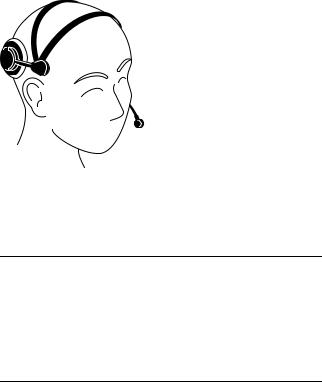
Flipping away one earcup
The headset features a “flip-away” earcup for single-sided listening.
Adjusting the volume directly on the audio system
Connect the headset to the corresponding sockets of your audio system. Adjust the volume directly on the audio system.
CAUTION! Hearing damage due to high volumes!
This headset is capable of producing high sound pressure levels. Higher volumes or longer durations can damage your hearing!
Set the volume to a medium level. Make sure that you can hear critical environmental sounds and warning alarms.
6
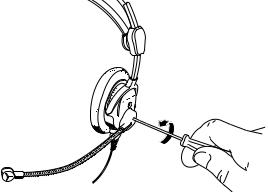
Adjusting the microphone sensitivity
The microphone sensitivity has been factory pre-set to 80 mV/Pa as per RTCA DO-214. You can change the microphone sensitivity by turning a small screwdriver in the direction of the arrow.








 +
+
–
7
